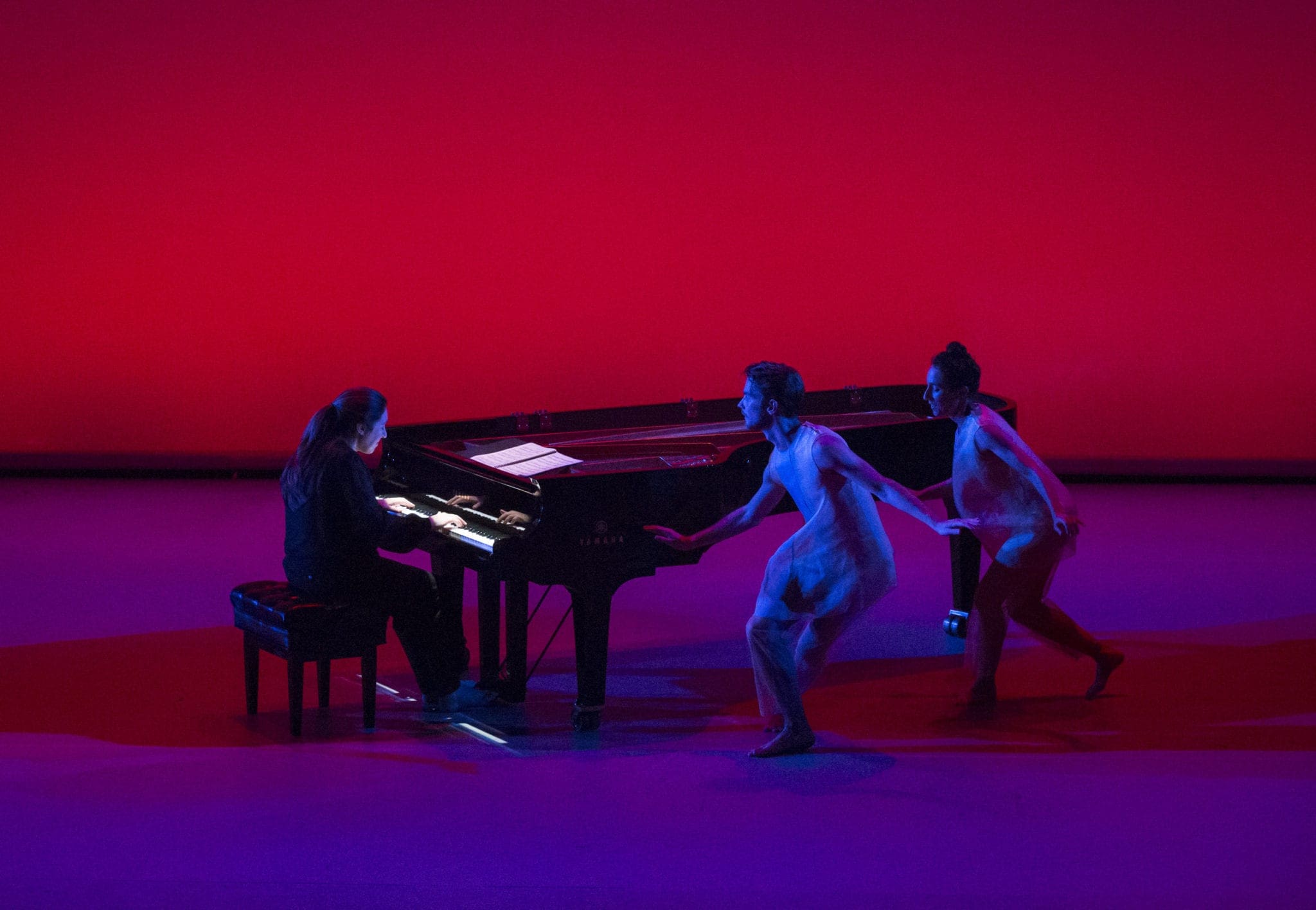


When pianist Simone Dinnerstein and choreographer Pam Tanowitz began discussing an evening-length dance collaboration in 2015, they faced an obvious question: what would they perform? Bach was a clear choice for Dinnerstein, who became a sudden classical star in 2007 with her self-financed interpretation of Goldberg Variations. The New Yorker hailed Dinnerstein’s “unapologetically romantic way with Bach,” while Slate praised “the dreamlike fugue state that Dinnerstein induces,” calling her recording of the work “an extended fairy tale, a far-flung journey recounted by firelight, a lullaby.”
Tanowitz’s extensive résumé, however, hinged largely on contemporary scores, so she hesitated to pursue Bach, especially since Jerome Robbins’ own 1971 setting remained a firm touchstone. Dinnerstein, who performed the Robbins setting with the Paris Opera Ballet in 2016, persisted. After all, as a choreographer, Tanowitz had long challenged and reworked classic dance forms and ballet motifs, playfully manipulating the past with wit and a touch of whimsy. Why not do the same with the Goldberg?
On Friday, October 6 and Saturday, October 7, 2017, Duke Performances — a longtime supporter of Dinnerstein and the lead commissioner for this project — presented the world premiere of New Work for Goldberg Variations, an evening-length piece for piano and seven dancers, at Reynolds Industries Theater. Following a weeklong production residency at Duke, New Work for Goldberg Variations features Dinnerstein performing the Bach at center stage, with the ensemble dancing around the piano. It is a bold new piece. “I desire to create something that will be inherently dangerous for both of us as artists,” says Tanowitz of the work, “in which everything we reveal to each other is woven into the fabric of her playing and my choreography.”
“… a riveting dialogue of movement and music.”
The New York Times
Photos by Marina Levitskaya
The wonderful thing about great music is its sense of potential. Masterpieces contain more than is possible to realize in one performance. That is the beautiful thing that keeps music fresh for me, even though I spend many hours every day living with it. As an interpreter, my goal is not to get a piece of music “right.” That final resting place of a fully and finally satisfying performance is an illusion. Instead my goal is to satisfy some of the potential in the music. By changing one thing, you quickly discover that other things have changed too. Through the accretion of those changes new aspects of the music reveal themselves.
I have been playing the Goldberg Variations for sixteen years. Recently I’ve begun to feel that there is no need to keep the piece solely to the keyboard. Last year I collaborated with some great string players to create a Goldberg Variations for string orchestra and this year I’ve had the joy of working with Pam Tanowitz to create a three dimensional Goldbergs with music and human bodies intertwined. The many voices of the Goldbergs are so vibrant and distinct that it made wonderful sense for them to be embodied.
Pam has been the perfect person to discover a new Goldbergs with dance. She was not interested in a literal illustration of the piece and neither was she interested in a strict metrical response. I was thrilled to discover that she didn’t even want her dancers to count. Instead she has looked for density and irregularity in her work. I find that a lot of discussion about music, whether through historical or harmonic analysis, has the effect of taking music from world of aural abstraction and placing it in something more ordered and prosaic: what kind of trills Bach would have used, for example, or which voice ought to have primacy at any one moment. Pam has ignored all of that and created her own physical world full of its own abstractions.
What a pleasure it has been to escape the solitude of the piano. Instead of experiencing the Goldbergs alone in a room, I’ve done it in the company of dancers, all of whom have their own response to the music and their own physical discipline that extends beyond ears and fingers. On the first page of the score, Bach writes that the variations are written for the refreshment of the spirit. That has been my experience of this collaboration with Pam.
— Simone Dinnerstein
ENSEMBLE
Maggie Cloud
Jason Collins
Christine Flores
Lindsey Jones
Maile Okamura
Melissa Toogood
Netta Yerushalmy
Piano
Simone Dinnerstein
Choreography
Pam Tanowitz
Lighting/Visual Design
Davison Scandrett
Costume Design
Reid & Harriet Design
Producer
Aaron Mattocks
Conceived by Simone Dinnerstein and Pam Tanowitz.
“Goldberg” Variations, BWV 988, Johann Sebastian Bach (1685-1750)
New Work for Goldberg Variations was commissioned by Duke Performances / Duke University & Peak Performances / Montclair State University, co-commissioned by Opening Nights Performing Arts / Florida State University & Summer Stages Dance at the Institute of Contemporary Art/Boston & received creative development support from the Maggie Allesee National Center for Choreography (MANCC) at Florida State University, The Yard at Martha’s Vineyard, the NYU Center for Ballet & the Arts & New York City Center. New Work for Goldberg Variations was made possible by the New England Foundation for the Arts’ National Dance Project, with lead funding from the Doris Duke Charitable Foundation & The Andrew W. Mellon Foundation & support from the Mary Duke Biddle Foundation. General Operating support for Pam Tanowitz Dance was made possible by the New England Foundation for the Arts’ National Dance Project with funding from the Doris Duke Charitable Foundation.